 COUNTRY OF ORIGIN
COUNTRY OF ORIGIN• Ecuador
The University of Crafts and Trades promoting know-how and cultural identity
The University of Crafts and Trades in practice
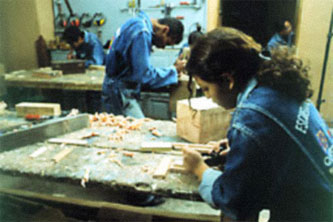
The University of Crafts and Trades in Ecuador is an innovative, universal instrument for the valorisation of knowledge and the transformation of higher education, which developed from the practices being carried out in many areas of Latin America.
Specifically, the University of Crafts and Trades aims to consolidate the country’s existing knowledge. Below is a description of the Quito University of Crafts and Trades, the study programme of the San Geronimo University College of Havana and the themes of higher education programmes in Andean areas.
THE QUITO UNIVERSITY OF CRAFTS AND TRADES
The Quito University of Crafts and Trades was established in 2004 as an educational centre specialising in the training of technicians and artisans for the preservation and valorisation of the historical heritage of Quito and the country. The UNESCO Andean Regional Office promoted and supported the process.
The municipality of the Quito metropolitan district provided an important civil building, built in the 18th century, in the old part of Quito for the University of Crafts and Trades. It is an 8,064 square metre building consisting of two cloisters, a chapel and gardens. It is built in adobe and brick, tiled, and with wooden columns on stone pilasters.
Quito, capital of the Republic of Ecuador has considerable cultural heritage dating back to the pre-Colombian, colonial, republican and contemporary periods, and has been declared a UNESCO world heritage site (1978). In the 1970s Quito started a process to valorise, preserve and develop its heritage. With the support of countries like Spain and Belgium, important work was carried out to preserve buildings and works of art, some of which were in danger of being destroyed. The Spanish International Cooperation Agency has three workshop schools in the cities of Quito and Cuenca.
Despite the country’s considerable heritage, no university offers a History of Art degree, and courses organised by other educational institutions are disorganised and isolated, not enough to provide the training required by specialists in this field. Since the 1970s a degree course in museography and restoration has been available, but there is a need for updated short courses. Although the development of the arts in Ecuador is studied, appropriate methodologies, specialised management, a contemporary vision and above all an academic education is needed to enable students to carry out research in the best possible way.
Despite the fact that building techniques and other skills have been preserved in Ecuador much has disappeared, especially the intangible heritage that is the essence of village culture. The lack of labour and apprentice organisations, such as the guilds of the colonial era, which handed down their skills from generation to generation, is one of the causes of the loss and disappearance of many techniques.
Since cultural activities have the potential to generate added value and employment, especially in the areas of tourism and development, the University of Crafts and Trades strives to make people and visitors aware of the importance of cultural heritage, so that it can be looked after, safeguarded and promoted. Together with local governments, the University promotes projects in support of the development of arts and crafts to promote traditional techniques and motifs and improve the quality of life of craftsmen.
For these reasons, the University of Crafts and Trades Project in Ecuador focuses on valorising, preserving and developing historical heritage through a programme that involves the following strategic activities:
- Restoration work on the building that will be housing the University, through workshops specialising in restoration and preservation of works of art and buildings: architecture, painting, sculpture, stonework, paper, etc.
- Partnerships with trade unions to preserve and spread the knowledge of age-old techniques and develop them for the preservation of heritage: engravers, joiners, carpenters, sculptors, painters, goldsmiths, silversmiths, blacksmiths, stonecutters, master builders, parchment makers, confectioners, shoemakers, hatters, chair makers, muleteers, millers, locksmiths, and others. Every culture on the planet has an enormous wealth of skills and knowledge
- Participation of craftsmen and experts in project work, jointly putting forward new arts and crafts proposals to be implemented with traditional techniques
- Partnerships with the tourist sector, governments, specialised centres, universities and workshops in Latin America, the Caribbean and other continents, especially Europe
- Study programmes and formal training course recognition procedures defined in collaboration with the Higher University Council
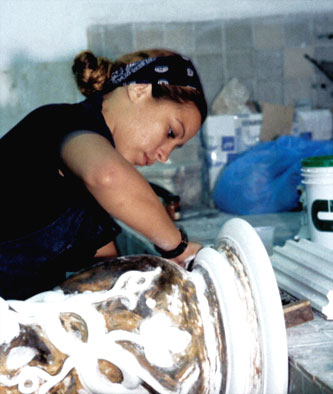
The training activities of the University of Crafts and Trades are aimed at: artisans, construction workers, experts, undergraduates and postgraduates (history of art and the preservation and valorisation of national and international heritage), young people, tourist developments enterprises.
The University of Crafts and Trades programme:
- Undergraduate, master’s and doctorate courses in the history of art, archaeology, museology, museography, preservation, restoration of works of art and buildings, cultural management, cultural tourism and the development of arts and crafts
- A centre for the preservation and restoration of works of art and buildings, including laboratories, disinfection chambers, and professional workshops for the packaging of works of art, etc.
- Vocational workshops to preserve colonial period construction techniques originating in Spain and other European countries
- Workshops to preserve the construction techniques used in works of art and buildings
- Temporary exhibition rooms to promote the knowledge and development of the arts in Ecuador, America, Europe and other countries
- Multi-purpose rooms for short courses, seminars, conferences, concerts, arts and crafts exhibitions
- Areas equipped with modern communication and information technology to facilitate networking and scientific technical dialogue with national and international institutions
- Documentation and research centre and technical library
- Educational workshops for children, craftsmen, senior citizens
- Storehouse for handicrafts, replicas and other tourist souvenirs
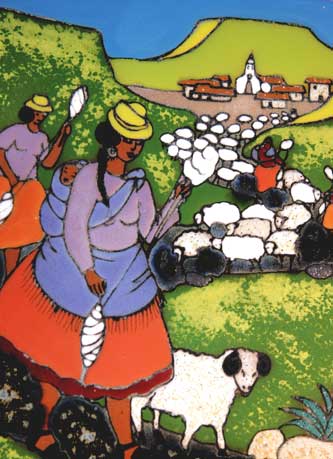
The university has a modular and flexible organisation. Educational and training processes are carried out by autonomous multi-disciplinary teams. These teams operate within a network, leading discussions on problems, themes or fields of activity and thought. Training activities are carried out with the support of laboratories, workshops, creative or innovative areas, enterprises, institutions, etc. The courses generate income by promoting commercial and tourist activities within the training process.
University training is complemented by three essential support activities that guarantee the study of: current affairs and present-day opportunities; history, future scenarios and strategic vision; ethics, values and universal understanding. The courses last between three and five years, depending on the knowledge or know-how being studied. Parts of the training courses are carried out in partner institutions or in institutions with which agreements have been stipulated. The University of Crafts and Trades also provides services for other institutions
COURSES AT THE SAN GERONIMO UNIVERSITY COLLEGE OF HAVANA
The San Gerónimo University College of Havana opened in November 2006 in the same location as Cuba’s first university, founded in 1728, the Royal Pontifical University of Havana. This higher education institute is directed and coordinated by the Office of the Historian of the City of Havana, in close collaboration with the Ministry of Higher Education, universities and other Cuban and international higher education centres.
The University College offers various postgraduate vocational courses (degrees, master’s degrees, and doctorates) in the regeneration of old town centres. The first degree course offered was on the preservation and management of historical and cultural heritage. The university course is aimed primarily at young people that have graduated from workshop schools and those working on the regeneration of the old part of the town, giving people that have reached a certain professional level (renovators, archaeologists, master builders) the chance of having a university education in an area closely connected with their work.
More than 600 young people have graduated from the four workshops schools in Havana. The schools provide young people with the opportunity of learning the skills of restoration work: stonework, ironwork, glass work, carpentry, etc. The methods used involve putting theory into practice in restoration work, thus guaranteeing graduates the chance of a job. The goals of these schools extend beyond the creation of human resources trained in restoration work and the preservation of crafts and skills in danger of disappearing to the social inclusion and integration of young people that have no schooling or work.
Study programmes in the University College involve a general study module and four specific modules, depending on the course chosen by students: archaeology, museum science, socio-cultural management, and urban management. There are ten fields of study: world historical heritage; world cultural heritage; history of Cuban society and culture; cultural and historical heritage and its preservation; methods and techniques for heritage research; archaeological study and heritage management; heritage and urban management; foreign languages.
These 10 fields contain more than 80 subjects ranging from philosophy to ancient music, applied computer science, palaeography, archaeology, anthropology, urban sociology, economic management, classical languages (Latin, Greek,) and native languages (Quechua, Aymará), to mention just a few. The professors teaching this course are mostly highly experienced and skilled specialists and experts from the Office of the Historian.
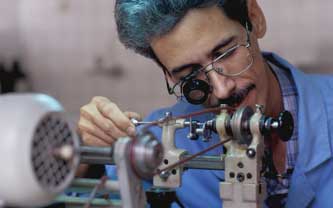
THE VALORISATION OF ANDEAN KNOW-HOW
Andean know-how is present in numerous traditional trades, still being performed in contemporary society. This provides the basis for the work carried out by the University of Crafts and Trades.
Organic farming, seed banks, and food safety. Andean, Mesoamerican and Amazonian farmers use methods that involve clean farming, the preservation of original seeds and the cultivation of important alimentary species such as amaranth (quinua, quihuicha, etc.). PRATEC and NUVICHA in Peru have a lot of experience in the preservation and valorisation of these practices and skills, which improve the environment and food quality.
Clean and integral water management. Ancient American practices presently used by indigenous populations provide better management of this essential element, a crucial global environmental issue.
Soil improvement, management and conservation. Indigenous farmers, whose practices are based on ancient American traditions, provide good examples of soil management for farming and pasture, such as the raised fields of the Ecuadorian sierra, the Peruvian Waru-Waru or the Bolivian Suka Kollus. These environmentally friendly practices involve clean soil management, equity and safe food for great masses of the population.

Desert agriculture. This is one of the most significant examples of extreme ecosystem management. The sunken fields of the Peruvian and Chilean desert provide balanced and clean examples of desert agriculture, which can generate further jobs and offer a living to whole communities of people.
Agriculture in wetlands or areas subject to periodic flooding. This is another example of extreme ecosystem management, soil and water conservation, exploiting natural cycles rather than fighting them as in imported foreign techniques. The “Mojana” region in Colombia, the Mayan biosphere in Guatemala, the Brazilian and Andean wetlands are examples of ancient know-how that can be recreated to achieve the same results.
Traditional medicine and useful plants, the quest for pharmacological patents. These processes are carried out by the Chapingo University in Mexico, PRATEC and NIVICHA in Peru, and in native communities throughout America, valorising medical practices that complement allopathic medicine and improve national public health services.
ARTS AND CRAFTS WORKSHOPS
Arts and crafts are one of the most representative aspects of the identity of a population, region or cultural area, and the repository of many of its values. Arts and crafts represent a real alternative to science and technology as an instrument for development. Andean countries are part of the cultural traditions of ancient America (from the earliest settlements to the 15th century and the ‘conquista’), which still live on in many inaptly named ‘indigenous’ populations. The ‘Fundacion para el Pensamiento Americano’ of Medellin, Colombia, organises training workshops to reintroduce useful expertise into contemporary society. This traditional know-how can help craftsmen reap the benefits of expanding globalisation.
Jewellery and metallurgy
- Designs recreated (not copied) from the magnificent examples of metalwork in museums of indigenous arts and crafts
- Individual and appropriate technology (gleaned from these works)
- Readily available raw materials
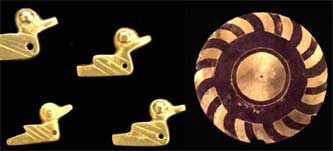
An example is the jewellery recreated from the designs that can be seen in the Gold Museum of the ‘Banco de la República de Colombia’, using techniques such as hammering, embossing, gold-plating and lost wax casting, developed by original populations and studied by researchers. In Colombia varying qualities and colours of gold are mined and found in alluvial deposits. Reintroducing these crafts and skills into the market gives indigenous populations and poor miners the chance to earn extra income by selling products at a fair price, promoting more environmentally friendly extraction techniques, and offering the world some unique products.[/list]
Textiles
- Designs recreated using pre-Columbian and present-day indigenous American designs
- Techniques for the production of cotton or woollen yarn, colouring and weaving
[list]Readily available raw materials (high-quality cotton, alpaca and vicuña wool, the finest in the world)
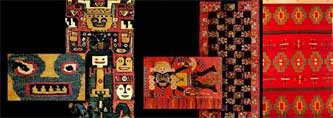
The extraordinary wealth of ancient American textiles, all with amazing designs, began with the Paracas culture (600 AD); a unique technology allowed many of these fabrics to be preserved to this day. It is a tradition that is similarly found in North America, Mesoamerica, Central America, the Andes and the Amazon, employing different techniques, fibres and designs but all adding to the wealth of this tradition.[/list]
Pottery
- Design recreated in the wake of the extraordinarily tradition that started in ancient American times and has continued to the present day
- Technology deriving from the same tradition (handling of materials, dyes, firing techniques etc.)
- Extremely varied raw materials offering endless possibilities
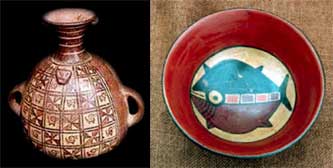
Pottery has many uses: art, domestic or everyday utensils, crockery, moulds, items used in other industries. The development of these skills (metallurgy and jewellery, cloth making and pottery), from a local perspective, recreates cultural identity, protects the environment, and improves the living conditions of artists and artisans. These skills can be usefully employed by businesses and industry (designs, appropriate technologies for new products), and, at a more sophisticated level, these cultural traditions can find a place in the world market.
DOWNLOAD THE BROCHURE PDF
English (1.4 MB)Spanish (1.4 MB)
French (1.4 MB)
ONLY TEXT
•The University of Crafts and Trades in practice
•Promoting the University of Crafts and Trades in other countries







